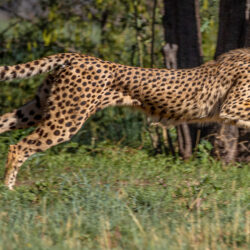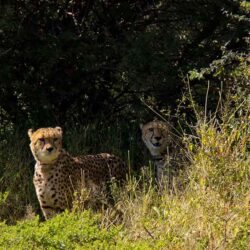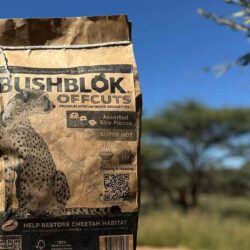Deploying eShepherd™ Collars and Foxlights in Otjituuo Conservancy
-

- by Gabriela Fleury March 21, 2018

Cheetah Conservation Fund’s Human Dimensions Research team, consisting of a conservation biologist, a veterinarian and CCF’s smallstock manager, were off January 22nd to Otjituuo Conservancy in the Eastern Communal Conservancies of Namibia to deploy an innovative new predator deterrent. eShepherd™ collars, made locally in South Africa, are a relatively inexpensive (N$1359) per unit method of preventing livestock losses to carnivores in the field. As most losses to carnivores occur whilst livestock are out grazing, the eShepherd collar could be an invaluable solution for farmers who are unable to hire full-time herders.

The eShepherd collar goes around the neck of a goat, sheep, or calf and when a predator chases the animals in a herd, this triggers the collar to emit a high-pitched sound alarm that is meant to deter the predator that is attacking. eShepherd collars are used in a ratio of 1 collar per 10 livestock, so it is best that they are used in small herds. The first study of its kind in Namibia, the collars will stay in place late Jan 2018 – late Jan 2019 (as the collars have an average battery life of 15 months, and come with the battery in place). We are testing how well the collars work to prevent livestock losses to carnivores, and will follow up with individuals every four months in the study period, as well as with their neighbours who do not have the collars, to do questionnaires to record livestock losses to predation.

All of the farmers were very excited to receive their eShepherd collars and their packets of materials on integrated livestock and predator management in the local language of Otjiherero. Over the course of two days, we deployed twenty-five smallstock collars among five different farmers, as well as four Foxlight systems with two farmers who were losing livestock in their kraal (livestock enclosure).
These solar-powered Foxlight systems are put on the enclosures, and at night, when most losses occur, they flash in a randomised pattern that mimics a person walking around the kraal with a flashlight. With both of these deterrent types, we are excited to get an idea of how well they work in Otjituuo Conservancy to better assist farmers in preventing their losses using nonlethal deterrents. Tools for reducing livestock losses to carnivores, should benefit both conservation and farmers in order to ensure the safeguarding of farmer livelihoods as well as the future of vulnerable wildlife and the ecosystems that they support.
Update on the research project
Find out how the study went by visiting our Resource Library.
Related Reading
-
October 14, 2025
Cheetahs Were Born to Run -
July 3, 2025
Double Your Donation During July and August




